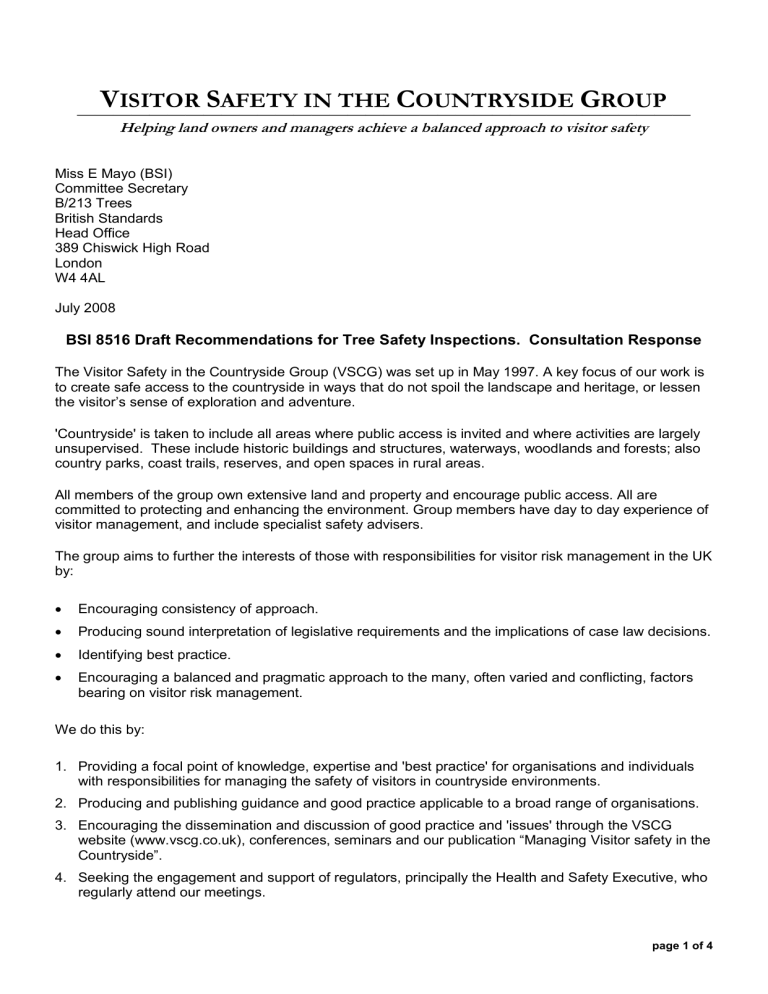Helping land owners and managers achieve a balanced approach

V
ISITOR
S
AFETY IN THE
C
OUNTRYSIDE
G
ROUP
——————————————————————————————————
Helping land owners and managers achieve a balanced approach to visitor safety
Miss E Mayo (BSI)
Committee Secretary
B/213 Trees
British Standards
Head Office
389 Chiswick High Road
London
W4 4AL
July 2008
BSI 8516 Draft Recommendations for Tree Safety Inspections. Consultation Response
The Visitor Safety in the Countryside Group (VSCG) was set up in May 1997. A key focus of our work is to create safe access to the countryside in ways that do not spoil the landscape and heritage, or lessen the visitor’s sense of exploration and adventure.
'Countryside' is taken to include all areas where public access is invited and where activities are largely unsupervised. These include historic buildings and structures, waterways, woodlands and forests; also country parks, coast trails, reserves, and open spaces in rural areas.
All members of the group own extensive land and property and encourage public access. All are committed to protecting and enhancing the environment. Group members have day to day experience of visitor management, and include specialist safety advisers.
The group aims to further the interests of those with responsibilities for visitor risk management in the UK by:
Encouraging consistency of approach.
Producing sound interpretation of legislative requirements and the implications of case law decisions.
Identifying best practice.
Encouraging a balanced and pragmatic approach to the many, often varied and conflicting, factors bearing on visitor risk management.
We do this by:
1. Providing a focal point of knowledge, expertise and 'best practice' for organisations and individuals with responsibilities for managing the safety of visitors in countryside environments.
2. Producing and publishing guidance and good practice applicable to a broad range of organisations.
3. Encouraging the dissemination and discussion of good practice and 'issues' through the VSCG website (www.vscg.co.uk) , conferences, seminars and our publication “Managing Visitor safety in the
Countryside”.
4. Seeking the engagement and support of regulators, principally the Health and Safety Executive, who regularly attend our meetings. page 1 of 4
At present the group members are:
British Waterways
Cheshire County Council
Peak District National Park Authority
The National Trust
English Heritage
Environment Agency
Forestry Commission
Natural England
The Royal Parks
The Woodland Trust
Royal Society for the Protection of Birds
Historic Scotland
This consultation response represents the unanimous view of all our members with respect to our interest in managing visitor safety . We have not specifically considered other issues such as occupational health and safety and risk to property.
However, most of our members will be making individual responses to the BSI consultation, which will deal with these other concerns.
The Visitor Safety in the Countryside Group does not support the proposed British Standard
Recommendations for tree safety inspection.
Principally this is because the cost and complexity of the inspections that would result from application of the standard is not proportionate to the level of risk from trees.
In reaching this conclusion, the VSCG has taken into account the Health and Safety Executive’s framework (Reducing Risks, Protecting People, 2001) and in particular, their guidance on tolerability of risk.
The boundary between the broadly acceptable and tolerable region in HSE’s tolerability of risk model is an individual risk of death of one in a million per annum.
For trees in high areas of public use the risk is only one in ten million. This is well within the broadly acceptable region, where the levels of risk are comparable to those that people regard as insignificant or trivial in their daily lives. In this zone, HSE would not usually require further action to reduce risks unless reasonably practicable measures are available.
The standard therefore proposes a level of inspection that appears to be way in excess of that required by the risk, which is stated in the introduction as being "---generally present at very low and acceptable levels." The introduction of a BSI standard (7.3) that will require expert inspection (e.g. by an arboriculturalist) at least every five years of all trees that could possibly harm persons or property is not a reasonably practicable measure. page 2 of 4
Visitor Safety in the Countryside Group Recommendations
The VSCG has recently produced guidance for tree safety management. This is available to read and download, free of charge, on our web site. ( http://www.vscg.co.uk/good-practice/published/tree-safetymanagement )
A copy of this guidance is attached, for ease of reference. This embodies our recommendations for tree safety management, including the nature of tree inspections. To a large extent, this effectively represents our response to your consultation draft. You will appreciate that it is not possible to incorporate this within the constraints of your web-based response structure.
Overall, the inspection regime is complex and confusing. Rather than use vague terms such as 'expert' and 'lay', it would be more useful if the standard defined the competences required to carry out the various levels of inspection, which we consider should not exceed three.
Zoning by Levels of Use
A key element of our guidance is to use zoning in accordance with levels of public use. High use zones typically include areas next to railways and busy roads; heavily used car parks, picnic areas, gardens and playgrounds; any areas where large numbers of people congregate, (including special events). We recommend that:
“ High-use zones should be inspected as your first priority. The species, health and location of trees will have a bearing on the levels of risk. This, in turn, will help determine whether any risk controls are necessary. Unless a specialist is helping with the initial inspection, you should consider whether you need help from an arboricultural specialist to diagnose problems with individual trees, advise on appropriate remedial work and work out when further inspection is necessary.”
Frequency of Inspection
The use zones have a significant bearing on the frequency of inspection. Trees in high use zones are typically inspected once a year.
Zones of medium use have fewer visitors and are likely to be inspected less frequently (maybe every three or even five years).
Low use zones typically have restricted access or few visitors. They may be remote or well away from paths. These zones may have no formal inspection procedure, yet the draft BSI standard (7.1) suggests that layman tree owners should be familiar with the condition of their trees, most suitably facilitated by regular observation and/or annual inspection.
There will be many layman tree owners with trees that present little or no risk to the public, for example farmers and landowners with large estates but no public access. Annual inspection is inconsistent with other guidance in the standard, representing a high frequency of inspection despite a very low level of risk.
Data recording
Section 4.3 gives advice on data to be recorded. It is solely focussed on tree inspection. There is insufficient consideration of who might be harmed, likelihood and consequences. page 3 of 4
Legal and related considerations
Section 5 is solely concerned with trees next to roads. It should either be defined as such, or the considerations widened in scope.
Quantifying the risk from hazard trees
Section 6 notes th at an arboriculturalist’s judgement remains the most reliable analytical tool when quantifying risk. Undoubtedly skill and experience is needed to assess the condition of hazard trees.
However, the section on risk assessment appears to muddle quantitative and qualitative assessment and leaves the reader with little further help. Certainly, whoever undertakes the risk assessment needs to have good advice on the state of the trees, but we feel a good knowledge of the site and its visitor profile is equally important.
Quantifying benefit from retention of trees
There does not seem to be adequate provision for considering the benefits of trees.
Conclusion
BS 8516, as currently drafted, would apply to all trees, irrespective of size and location. It does not provide an option for no inspection of low-risk trees in remote or inaccessible sites. It perhaps confuses overall tree risk assessment with “tree safety inspection” that is the BSI document’s title. In the introduction, the draft standard notes that:
"The inherent risks associated with trees mean that it is a mistake to manage them in an overly riskaverse manner. In addition to considerations of tree safety, it is important that management decisions are taken in light of their wider benefits (aesthetic, ecological, environmental and sociological).
Management decisions to address identified hazards that exceed what is necessary to the detriment of these benefits are inappropriate."
The members of VSCG do not disagree with these words but unfortunately the detailed requirements and implications of the document achieve a different effect than these worthy sentiments.
There may be merit in a standard that prescribes the detail of an expert tree inspection, or a need for a standard for the inspection of trees next to highways or in urban areas. But BS 8516 would confuse, rather than help, in managing visitor safety in the countryside.
Ken Dodd
Chair
Visitor Safety in the Countryside Group page 4 of 4








